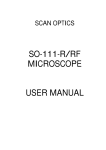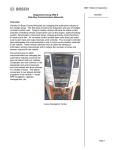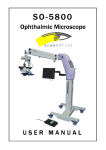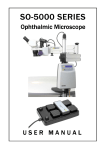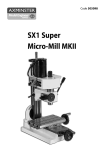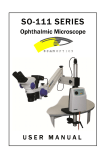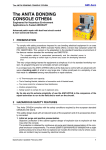Download SO-161-R User Manual v1.0 - Frank`s Hospital Workshop
Transcript
SCAN OPTICS SO-161-R MICROSCOPE USER MANUAL SO-161-R Ophthalmic Microscope User Manual Page 2 of 18 CONTENTS CONTENTS_____________________________________________________________ 2 LIST OF FIGURES _______________________________________________________ 2 INTRODUCTION ________________________________________________________ 3 INTRODUCTION ________________________________________________________ 3 PARTS LIST ____________________________________________________________ 5 ASSEMBLY INSTRUCTIONS _______________________________________________ 6 TABLE MOUNTING ___________________________________________________ 6 MOUNTING TO THE SO-331 FLOOR STAND______________________________ 7 BATTERY CONNECTION, OPERATION, MAINTENANCE AND SAFETY _____ 9 USING THE MICROSCOPE ______________________________________________ 10 ARTICULATED ARM _________________________________________________ 10 POSITIONING THE MICROSCOPE______________________________________ 11 POWER SUPPLY CONTROLS __________________________________________ 11 LAMP REPLACEMENT _______________________________________________ 12 STERILISATION AND CLEANING______________________________________ 13 CARE OF THE OPTICAL HEAD ________________________________________ 14 ADJUSTING FOCUS FRICTION ________________________________________ 15 MOULD PELLET REPLACEMENT ______________________________________ 15 SPECIFICATIONS ______________________________________________________ 17 LIST OF FIGURES Figure 1: SO-161-R Microscope Figure 2: SO-161-R Microscope shown with SO-331 Floor stand Figure 3: Assembling the SO-161-R Microscope Figure 4: Assembling the SO-161-R Microscope on SO-331 Floor stand Figure 5: SO-161-R Power supply bottom panel Figure 6: Articulated arm features Figure 7: SO-161-R Power supply top panel Figure 8: Changing the lamp Figure 9: Sterilisable covers Figure 10: Replacing the mould pellet Issue number 1.0 X:\Current User Manuals\SO-161-R User Manual v1.0.doc 3 4 7 8 9 10 11 12 13 15 SO-161-R Ophthalmic Microscope User Manual Page 3 of 18 INTRODUCTION Please read the following information carefully before installing and using the Scan Optics SO161-R Ophthalmic microscope. Scan Optics is responsible for the safety, reliability and performance of the equipment only if it is used in accordance with these instructions. This microscope is designed for use by a certified practitioner, for magnified observation of patients, and for use in an operating theatre as an observation aid during surgery. Environmental storage and packing conditions of 60-95% relative humidity and 10-40 °C, are recommended for this product. No parts or accessories supplied with this microscope are supplied in a sterile condition. Apart from those instructions within this manual, there are no user-serviceable parts in this microscope. Scan Optics will retain the discretion to advise whether any repairs may be taken out by external qualified technical personnel, or whether part(s) of the microscope must be returned to the manufacturer’s premises for service or repairs to be carried out under warranty or otherwise. Where appropriately qualified technical personnel are identified by a user, and ratified by Scan Optics, then Scan Optics will make available on request any information that will assist in repairing the equipment. Figure 1: SO-161-R Microscope Issue number 1.0 X:\Current User Manuals\SO-161-R User Manual v1.0.doc SO-161-R Ophthalmic Microscope User Manual Figure 2: SO-161-R Microscope shown with SO-331 Floor stand Issue number 1.0 X:\Current User Manuals\SO-161-R User Manual v1.0.doc Page 4 of 18 SO-161-R Ophthalmic Microscope User Manual Page 5 of 18 PARTS LIST MAIN ASSEMBLIES Power supply assembly Articulated Arm Assembly Microscope Assembly includes power supply mounted on G-clamp/pillar assembly and safety clamp includes horizontal arm and adjustable pantograph arm includes tilt adjuster, microscope head, guide handle, lamphouse, universal arm and cable CABLES Mains Cable 12V dc Supply (Battery) Cable 1 1 OTHER Focus Knob Sterilisable Covers Eyepieces 2 2 TOOL KIT Spare lamp Socket keys Lens Cloth 1 set 7: 1.5mm, 2mm, 2.5mm, 3mm, 4mm, 5mm, and 6mm 1 OPTIONAL ACCESSORIES SCAN OPTICS PART NUMBER Floor stand (heavyweight) Floor stand (lightweight) Binocular assistant microscope Pupillary distance setter Side handle Guide handle SO-331* SO-311 SO-1420 SO-1510 *Note that in SO-161-R microscopes supplied with the SO-331 floor stand, the power supply assembly is mounted on a pillar fitting, not a G-clamp. Refer to this manual for details. Issue number 1.0 X:\Current User Manuals\SO-161-R User Manual v1.0.doc SO-161-R Ophthalmic Microscope User Manual Page 6 of 18 ASSEMBLY INSTRUCTIONS TABLE MOUNTING 1. 2. 3. 4. 5. 6. 7. 8. 9. 10. 11. Remove the power supply assembly from the carton, and fix it firmly to the table using the G-clamp knob. Use hand tightening only to fix the assembly in place – use of a spanner or pliers to tighten the screw may strip the thread or produce excessive deflection in the clamp. Move the safety clamp up the pillar to the desired height of the fixed arm, and lock it in place with the thumbscrew. Remove the arm assembly from the carton and loosen the elbow lock knob to allow the pantograph arm to rotate about the end of the fixed arm. Then place the arm on the pillar so that it rests on the safety clamp. Remove the head assembly from the carton and place the pin into the collet at the end of the pantograph arm. Tighten the wrist lock knob under the collet to secure the head assembly in place. Connect the lamphouse cable to the socket located on the top of the power supply box. Connect the mains cable to the IEC socket located on the under-side of the power supply box. Use the cable-retaining clip to secure the plug in place. Connect the other end of the mains cable to a reliable EARTHED mains power supply. Check the setting of the voltage selector located on the under-side of the power supply box. If necessary, change the setting to 120 or 240V as required, using a flat-head screwdriver or coin. Severe damage to the power supply may result if this is incorrectly set. Switch on the mains power supply at the mains socket. When the ON/OFF switch is selected to ON, the power supply indicator on the switch will light up. Remove the microscope eyepiece blanks from the head assembly and insert the eyepieces. Retain the eyepiece blanks in the eyepiece packaging for when the microscope is repacked. Do not discard the eyepiece blanks. When focusing the microscope, look with the right eye through the right eyepiece first and use the focus knob or foot control to bring a target into focus at the preferred magnification. Then look through the left eyepiece with the left eye and adjust the dial to compensate for any relative refractive error between the eyes. Remove two focus knob covers from the bag inside the carton. Push them into position on to the focus knobs on either side of the microscope. CAUTION: • Scan Optics recommend that ALL packaging materials be retained by the user in a safe place, in case of future transit needs. • All covers are intended to be sterilised before any operating procedures. • The mains power supply must have a protective earth conductor. If there in no earth conductor, or if the integrity of the earth conductor arrangement is in doubt, the equipment must be operated from a 12Vdc power source. Issue number 1.0 X:\Current User Manuals\SO-161-R User Manual v1.0.doc SO-161-R Ophthalmic Microscope User Manual Page 7 of 18 MOUNTING TO THE SO-331 FLOOR STAND 1. 2. 3. 4. Carefully lift the floor stand base out of the carton using the handles that are fixed to the top. The floor stand base is extremely heavy and should only ever be lifted with the assistance of another person. Place the floor stand base on the floor. Remove the pillar from the carton and place it in the floor stand base. Tighten the two grub screws using the 5mm socket key found in the tool kit to fix the pillar assembly in place. To fix the floor stand base, screw the knobs down until the stops are resting evenly on the floor, then screw the knurled discs down on to the floor stand base to lock the stops. To unlock the floor stand, screw the knurled discs back up, and then unscrew the knobs until the wheels can move freely. Place the pillar fitting/power supply assembly on the pillar and tighten the two grub screws to fix the assembly in place. Continue assembling the microscope from step 2 of the instructions for table mounting. Figure 3: Assembling the SO-161-R Microscope Issue number 1.0 X:\Current User Manuals\SO-161-R User Manual v1.0.doc SO-161-R Ophthalmic Microscope User Manual Figure 4: Assembling the SO-161-R Microscope on SO-331 Floor stand Issue number 1.0 X:\Current User Manuals\SO-161-R User Manual v1.0.doc Page 8 of 18 SO-161-R Ophthalmic Microscope User Manual Page 9 of 18 Figure 5: SO-161-R Power supply bottom panel MOUNTING TO THE SO-311 FLOOR STAND 1. 2. 3. Assemble the floor stand according to the instructions provided with it. Clamp the power supply assembly to the mounting plate at the top of the floor stand. Continue assembling the microscope from step 2 of the instructions for table mounting. CAUTION: • Scan Optics advise caution when using the SO-311 floor stand with this microscope. To prevent over-balancing, use sandbags or a similar method to weigh down the floor stand legs. Try to use the fixed arm and pantograph arm in a compact orientation to minimize the moment arm acting on the floor stand. BATTERY CONNECTION, OPERATION, MAINTENANCE AND SAFETY Scan Optics recommend the use of sealed rechargeable lead-acid 12V batteries such as Scan Optics Cat Nos. SO-251 (small, light, lower (7Ah) capacity) and SO-9210 (large, heavy, higher (35Ah) capacity). These batteries are maintenance -free and can be operated, charged or stored in any position without leakage. 1. 2. If the power supply is to be connected to a 12-volt dc supply, remove the battery cable from the carton and connect the cable to the 3-pin plug on the underside of the power supply. Connect the red battery clip to the positive battery terminal, and the black clip to the negative battery terminal. The power supply will not operate if the terminals are reversed CAUTION: • The 12-volt supply must be direct current. The power supply will not operate with 12 volts alternating current. • Do not charge these batteries in a sealed container. • Avoid short-circuiting batteries. • Old lead-acid batteries of any type must be disposed of correctly. It is recommended that they are recycled by an appropriate establishment who recycle car batteries. Lead acid batteries should not be disposed of with ordinary household or medical waste, as lead poisoning or acid trauma may result. • Where battery backup is used, Scan Optics recommends a periodical check of the battery to ensure it is charged and functional. Issue number 1.0 X:\Current User Manuals\SO-161-R User Manual v1.0.doc SO-161-R Ophthalmic Microscope User Manual Page 10 of 18 USING THE MICROSCOPE ARTICULATED ARM The articulated arm includes a number of features that enable the microscope to be adjusted in almost any position. 1. The horizontal arm may rotate about the vertical pillar by unlocking the pillar lock knob. To prevent the arm from rotating, simply lock the knob. 2. The pantograph (moving) arm may rotate about the end of the horizontal arm by unlocking the elbow lock knob. To prevent the arm from rotating, simply lock the knob. 3. The amount of force required to move the pantograph arm up and down may be adjusted by rotating the screw located at the top of the elbow joint. To adjust the gas spring force, first move the pantograph arm down to reveal the screw through the slot in the top of the arm. Use the socket key located in the toolbox to rotate the screw. To decrease the amount of force required to move the arm, rotate the screw clockwise. To increase the amount of force required to move the arm, rotate the screw anticlockwise. If the screw is adjusted to its limit, rotate the screw half a turn in the opposite direction to ensure the arm continues to operate smoothly. 4. The amount of friction in the pantograph arm may be adjusted by rotating the handle located on the side of the pantograph arm. The arm may be locked in any position or alternatively, the amount of friction can be set so that the arm is stable but will move when a force is applied. 5. The wrist lock knob located on the under-side of the end of the pantograph arm is used to lock the microscope assembly into place. To release the microscope assembly, simply unscrew the knob and lift the assembly carefully out of the collet. 6. The microscope head may be tilted up by some 5â and down by 45â by rotating the tilt adjustment knob. To tilt the head down, rotate the knob in the clockwise direction. To tilt the head up, rotate the knob anticlockwise. Figure 6: Articulated arm features Issue number 1.0 X:\Current User Manuals\SO-161-R User Manual v1.0.doc SO-161-R Ophthalmic Microscope User Manual Page 11 of 18 POSITIONING THE MICROSCOPE Note that the equipment must be located more than 25 cm away from any medical gas system or disinfection or degreasing system containing flammable vapour. The power supply must also be protected from liquid splashes and spills. 1. Set the instrument approximately in position by swinging the elbow as required. 2. Set the focus adjustment to the midway position by rotating the focus knob appropriately. 3. Adjust the height of the microscope by moving the arm vertically so that the work area is approximately in focus. Tighten the pillar and elbow lock knobs. 4. Check the eyepiece setting to ensure clear vision with each eye separately, and set the pupillary distance. Note that the working distance is increased by rotating both eyepieces in a clockwise direction, and reduced by rotating both eyepieces counter-clockwise. 5. The microscope can now be swung aside ready for use with a patient. 6. Swing the microscope over the patient 7. Tighten the pillar lock knob until the microscope is prevented from moving freely, but is still able to be moved when required. The friction of the arm and elbow knobs should be adjusted so that the movement feels uniform in all directions. 8. To swing the microscope out of the way, unlock the pillar lock knob and swing the microscope about the vertical pillar. It will remain in focus when returned to the work area. POWER SUPPLY CONTROLS Switch the microscope on using the mains switch – the LED mounted in the switch will glow when the microscope is switched on. Use the manual light intensity adjustment to obtain a suitable setting. Note that lamp life will be extended if a lower light intensity setting is used. Figure 7: SO-161-R Power supply top panel Issue number 1.0 X:\Current User Manuals\SO-161-R User Manual v1.0.doc SO-161-R Ophthalmic Microscope User Manual Page 12 of 18 LAMPHOUSE AND LAMP 1. 2. The lamp house on the SO-161-R ophthalmic microscope produces a coaxial light that provides a red fundus reflex from the back of the eye. The intensity of the light may be controlled from the top panel of the power supply. The lamp supplied has a rated average life of 50 hours, but the actual life of the lamp will depend on the intensity setting normally used. The highest setting will increase light output but will reduce lamp life. Conversely, running the lamp at the lowest setting will produce a lamp life of greater than 50 hours. It is strongly recommended that the lamp be replaced as a routine maintenance task, to reduce the possibility of failure during surgery. LAMP REPLACEMENT 1. 2. 3. Remove the toolbox from the horizontal arm by pulling it out horizontally. The spare lamp module is located at the end of the toolbox, and may be removed by pulling out horizontally. Pull out the old lamp module from the side of the lamp house by gripping the rectangular block located beneath the cable gland at the back of the lamp house. Place the replacement module in the lamp house so that the pins engage in the sockets and ‘click’ into place. When the old lamp has cooled down, it may be replaced by gripping the lamp holder at the sides where the rectangular cutout is located, and pulling the lamp out. Do not attempt to pull the lamp out by gripping the glass capsule. Push the new lamp into the socket so that the lamp flange sits flush on the front of the locating tube. Ensure that the new lamp is free of grease or fingerprints before replacement. Use of protective gloves during this procedure may be useful. Any grease marks should be removed with a solvent such as methanol to avoid reducing lamp life. This assembly is now ready for use as a new quick-change lamp module and may be replaced in the toolbox Figure 8: Changing the lamp Issue number 1.0 X:\Current User Manuals\SO-161-R User Manual v1.0.doc SO-161-R Ophthalmic Microscope User Manual Page 13 of 18 STERILISATION AND CLEANING 1. 2. 3. 4. 5. 6. 7. The removable covers may be sterilised by boiling, autoclaving, chemical sterilisation or gas sterilisation. One set of covers can be sterilised while the other is in use. The anodised and plated metal components can be wiped with any of the normal disinfectants. The plastic parts and the paintwork of the microscope assembly and the power supply may be affected by organic solvents. Do not autoclave or wipe with organic solvents such as ether, xylene or alcohol. To clean, use water-based solvents only. Focus covers are used to cover focus knobs only Zoom covers are used to cover the optional SO-1420 binocular assistant microscope focusing knobs and SO-1510 PD adjuster knob Guide handle covers are used for the optional guide handle and side handles CAUTION: • National authorities may require the use of specific sterilisation or disinfection methods. Figure 9: Sterilisable covers Issue number 1.0 X:\Current User Manuals\SO-161-R User Manual v1.0.doc SO-161-R Ophthalmic Microscope User Manual Page 14 of 18 CARE AND MAINTENANCE CARE OF THE OPTICAL HEAD 1. Cleaning the optical components. The eyepieces should be checked for cleanliness each time the instrument is used. Surface dust should be removed with a clean, soft brush. Fingerprints or grease may be removed by lightly wiping with a cotton cloth or lens tissue moistened with a 70:30 mixture of absolute alcohol (either ethanol or methanol) and ether. Do not use acetone as it may damage the surface coating. 2. Cleaning the plastic parts and paintwork. Use water based cleaners only. Do not use any organic solvent such as alcohol, ether or xylene. 3. Protection against mould. In hot and humid climates, it is common for mould to grow on optical surfaces. Cleaning and repairing the damage can be expensive and inconvenient. To minimise the risk of mould forming, do not leave the instrument without either eyepieces or eyepiece blanks inserted and always store the optical head in a sealed bag containing silica gel desiccant. In tropical climates, routine annual maintenance of the optical head is recommended. 4. Do not dismantle. With the exception of the anti-mould pellet, no parts inside the optical head of the instrument can be serviced by the user. Attempts to dismantle the optical head or prism cover will make any warranty void. Issue number 1.0 X:\Current User Manuals\SO-161-R User Manual v1.0.doc SO-161-R Ophthalmic Microscope User Manual Page 15 of 18 ADJUSTING FOCUS FRICTION The focusing system should allow the microscope head to be lowered and raised smoothly and easily, but should not allow the head to fall under its own weight. To adjust the friction, simply hold the plain (left) focus control knob and rotate the right focus control knob (marked “tension”) until the desired friction is achieved. To increase the friction rotate the knob clockwise, to decrease the friction rotate the knob anti-clockwise. MOULD PELLET REPLACEMENT Scan Optics microscopes are fitted with mould protection which lasts for approximately 3 years, however, this is dependent on the storage conditions and humidity of the local environment. In extreme tropical climates, it may be necessary to change the mould protection as frequently as every year. A guide to when the mould protection should be changed is placed on a sticker on the front of the microscope head. However, this is indicative only and users should be guided by their own experience and knowledge of local conditions. As a general precaution, always store the microscope head in a protective bag when not in use, and replace the eyepieces with the protective eyepiece caps. To replace the mould pellet: 1. Loosen the grubscrews holding the head in the bonder arm. 2. Lift the head out of the arm and remove the prism protector. 3. Carefully unscrew the objective lens, taking care not to damage the lamp house prism. 4. Use a Philips head screwdriver to remove the mould pellet. Push the end into the hole and lever off the surface. 5. Place the new pellet on the end of the screwdriver, remove the protective cover and fix to the same location where the old pellet was removed. 6. Screw the objective lens back on and replace the prism protector. 7. Replace the head in the bonder arm ensuring that the head is aligned to the front of the arm and secure by tightening the grubscrews. Figure 10: Replacing the mould pellet Issue number 1.0 X:\Current User Manuals\SO-161-R User Manual v1.0.doc SO-161-R Ophthalmic Microscope User Manual Page 16 of 18 TROUBLESHOOTING SYMPTOM CAUSE REMEDY No light No lamp/failed lamp Mains power failure Fuse blown Fuse repeatedly blows Incorrect voltage setting Replace lamp Use battery back-up Check and replace fuse if necessary Check mains voltage setting 110/220V Check mains voltage setting 110/220V Check mains wiring, do not use microscope if wired incorrectly. Use battery backup Increase intensity Replace lamp Clean eyepieces, prism and objective lens Recharge/replace battery Replace with lamp of correct specification Re-centre lamphouse on image centre (use adjusting grubscrews) Increase focus friction Mains power fault Low light level Intensity turned down Aged lamp Dirty optics Battery power low Incorrect lamp Lamphouse off-centre Microscope falls under own weight Blurred vision Insufficient focus friction Dirty optics Mouldy optics Refractive error Microscope unsteady Unstable surface Knobs loose Issue number 1.0 Clean eyepieces, prism and objective lens Carefully clean mould from optical elements and replace mould protection pellet Focus right eye first through RHS eyepiece then adjust LHS eyepiece to compensate for error Stiffen mounting surface with a plate Tighten adjustment knobs as necessary X:\Current User Manuals\SO-161-R User Manual v1.0.doc SO-161-R Ophthalmic Microscope User Manual Page 17 of 18 SPECIFICATIONS OPTICAL HEAD VIEWING SYSTEM Binocular, stereoscopic (convergence angle 12o ) Eyepiece tube inclination 45o MAGNIFICATION Fixed, 6.25 x Optional 9.4x eyepieces WORKING DISTANCE Lamphouse prism to object distance 165 mm FIELD OF VIEW 44mm REFRACTIVE ERROR Adjustment +5o to -5o , left eyepiece FOCUSING Range ± 25mm Control knobs removable for sterilisation INTERPUPILLARY DISTANCE Adjustable for PD range approximately 50 to 80mm ILLUMINATION ALIGNMENT Coaxial with viewing system LAMP 12V 50W quartz-halogen lamp FILTERS Internal ultraviolet and infrared filters AVERAGE LAMP LIFE Medium intensity: 50 hours ILLUMINATION 60,000 Lux approximately at maximum setting. LAMP CHANGE Plug in for fast change, no screws POWER SUPPLY MAINS POWER OUTPUT 220-240V/0.2A; 110-120V/0.4A 12V 50W INTENSITY CONTROL Continuous EARTHING via earth lead on mains cable (green/yellow) FUSE 250V/3A 20x5 mm CABLES Mains: Battery: Issue number 1.0 Length 5 metres Length 5 metres X:\Current User Manuals\SO-161-R User Manual v1.0.doc SO-161-R Ophthalmic Microscope User Manual Page 18 of 18 MOUNTING SYSTEM HEAD TILT +5â to -45â VERTICAL TENSION Adjustable gas spring to set lifting force DIMENSIONS Vertical pillar to head optical axis max 840 mm (33") Pantograph arm vertical range 320 mm (13") MATERIALS No ferrous metals to rust or corrode Issue number 1.0 X:\Current User Manuals\SO-161-R User Manual v1.0.doc




















